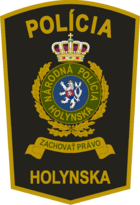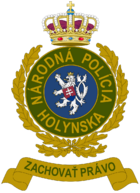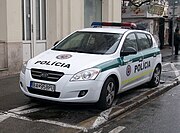National Police of Holynia
| National Police of Holynia Národná Polícia Holynska (Hornat) Národní Policie Holynska (Masovian) | |
|---|---|
 Patch of the National Police of Holynia | |
 Logo of the National Police of Holynia | |
 Badge of the National Police of Holynia | |
| Abbreviation | NPH |
| Motto | "Zachovať právo" "Maintain the right" |
| Agency overview | |
| Formed | 22 September 1891 |
| Employees | 70,000 |
| Jurisdictional structure | |
| Operations jurisdiction | Holynia |
| Size | 1,014,174 km2 |
| Population | 80,230,431 |
| Constituting instrument |
|
| General nature | |
| Operational structure | |
| Headquarters | National Police Center Cizekporok, Holynia |
| Sworn members | 43,000 |
| Unsworn members | 27,000 |
| Elected officer responsible |
|
| Districts | 28 |
| Website | |
| www.policia.gov.hk | |
The National Police of Holynia (Hornat: Národná Polícia Holynska or Masovian: Národní Policie Holynska), is the national police service of Holynia. The National Police dates back to 1891, originally as the Verejná bezpečnosť during the First Holyn Kingdom to maintain law and order in Cizekporok and Bystrica. It was reformed into a paramilitary force with expansive roles including public safety and investigative. Following the fall of communism in 1998, the Police Act of 1999 outlined the duties of the post-communist National Police. The act also permitted municipalities to form their own police forces. Large cities such as Cizekporok and Bystrica have since formed their own police forces. The National Police currently has a number of duties including local uniformed law enforcement duties, traffic enforcement, guarding government facilities and officials, protecting the royal family and investigating crimes. The headquarters of the National Police is located on Hladík cesta in central Cizekporok. The agency had 70,000 employees, of which 43,000 are sworn members. The National Police is led by Commissioner of Police, Milan Kuchár and is apart of the Ministry of Public Security.
History
The National Police of Holynia traces its history back to the Verejná bezpečnosť (VB) of the first Holyn Kingdom. VB units performed policing, firefighting and security service duties. VB units generally were located in large cities and larger country towns. In 1891, the Narodna Rada centralised all policing under the VB. The VB operated throughout the Holyn Revolution, with units declaring allegiance to both communism or the Royal family. The VB was reorganised after the revolution under the Committee of Internal Security (later the Ministry of Internal Affairs). The border services were removed from the VB in 1942, when the Border Guard Service was formed. In 1949, it lost its firefighting and security service duties, solely becoming a civilian police force.
In 1960, the VB was further split into the main VB, which conducted general policing services and the traffic police, responsible for motorway and traffic safety. In 1963, the VB was renamed the National Police in order to clearly define its role as a civilian police force. The police became increasingly involved in quelling unrest against the central government. In the 1980s, the National Police increased the size of its public order units by 200%. The National Police provided search and rescue services during the 1987 Vamik Dam collapse and the 1989 Łuków Volcano eruption. Criticism and allegations of abuse as unrest grew in Bogoria throughout the 1980s and 1990s. The National Police were deployed during the Bogorian War of Independence in 1997 to 1999. The National Police were tasked with cracking down on protests against the government in Cizekporok.
In 1999, the newly democratic Holynia began debating significant police reform. Growing corruption, human rights abuses and low public approval of the police led to the Police Act of 2000. The legislation created the Independent Police Conduct Office to initiate corruption investigations and handle complaints against the police. The act permitted municipalities to form their own police services, in lieu of using the National Police. The Public Security Ministry would ultimately be responsible for the municipal police services, however, the municipalities would be responsible for funding and training.
In 2000, the National Police unveiled a new emblem designed in conjunction with the Royal Heraldry Office.
Organisation
Leadership
- Commissioner of Police – Milan Kuchár
- Deputy Commissioner of Police – Július Havel
- Assistant Commissioner of Police – Ján Mečiar
- Assistant Commissioner of Police – Angelika Novomedská
- Assistant Commissioner of Police – Martin Chren
- Deputy Assistant Commissioner of Police – Patrik Čížik (Leader of Patrol Operations)
- Deputy Assistant Commissioner of Police – Ján Kováč (Leader of Investigation Operations)
- Deputy Assistant Commissioner of Police – Elena Kollárová (Leader of Specialist Operations)
- Deputy Assistant Commissioner of Police – Šimon Slavik (Leader of Tactical Operations)
- Deputy Assistant Commissioner of Police – Patrik Kráľ (Co-Leader of Professional Standards)
Patrol Operations
Patrol Operations is split into Patrol Command and Traffic Safety Command. Patrol Command is divided into five regions, further divided into areas and Patrol Operations Units (POUs).
Patrol Command
- Central Region
- Poltár area
- Cizekporok POU
- St. Sabas POU
- Chrenová POU
- Skalicky area
- Koszmály POU
- Dubovica POU
- Komárov POU
- Poltár area
- North Region
- Bytca area
- Bystrica POU
- Buzice POU
- Tvrdošky area
- Tisove POU
- Bytca area
- South Region
- Záhorie area
- Slatnik POU
- Hrabovka POU
- Ložín area
- Málaš POU
- Záhorie area
- East Region
- Benkove area
- Záhorce POU
- Palke POU
- Krivoklát POU
- Nosice POU
- Benkove area
- West Region
- Kálna area
- Jalovec POU
- Ligásovci POU
- Lačnov POU
- Kálna area
Traffic Safety Command
- Traffic patrol unit
- Motorway safety unit
- Traffic investigation unit
- Specialised accident investigation unit
Investigation Operations
Criminal Investigation Command
- Criminal investigation directorate
Station level and general pool detectives who investigate majority of crime within their respective jurisdictions.
Specialised Investigation Command
- Homicide and Major Crime directorate
- Murder investigation unit
- Missing persons unit
- Central courts support unit
- Special crimes unit
- Robbery and burglary directorate
- General robbery unit
- Vehicle theft unit
- Bank robbery unit
- Sexual offences directorate
- Human trafficking unit
- Child exploitation unit
- Prostitution unit
- Organised crime directorate
- Central organised crime unit
- Casino unit
- Money laundering unit
- Fraud unit
Specialist Operations
Protection and Security Command
- Protection directorate
- Royalty and specialist protection unit
- General protection unit
- Diplomatic protection unit
- Facility protection unit
- Counter-terrorism directorate
- Covert operations directorate
Special Command
- Aviation directorate
- Helicopter support unit
- Aircraft support unit
- Water patrol directorate
- Water patrol unit
- Water rescue unit
Tactical Operations
Tactical Command
- Tactical directorate
- Suppression unit
- Tactical response unit
- Search unit
- Public order directorate
- Central public order unit
- Tactical support directorate
- Mounted unit
- Explosives unit
- Operations unit
Professional Standards
Professional Standards Command
- Professional standards directorate
- Complaints Investigations unit
- Conduct Investigations unit
- Prevention unit
Ranks
Rank structure
Commanding officers
- Commissioner of Police
- Assistant Commissioner of Police
- Deputy Commissioner of Police
- Deputy Assistant Commissioner of Police
Senior officers
- Commander
- Chief Superintendent
- Superintendent
- Chief Inspector
- Inspector
Police officers
- Senior Sergeant or Senior Detective
- Sergeant or Detective Sergeant
- Senior Constable or Detective Constable
- Constable
Cadets
- Cadet
Insignia
| Rank | Commanding officers | Senior officers | Police officers | ||||||||||
|---|---|---|---|---|---|---|---|---|---|---|---|---|---|
| Commissioner of Police | Assistant Commissioner of Police | Deputy Commissioner of Police | Deputy Assistant Commissioner of Police | Commander | Chief Superintendent | Superintendent | Chief Inspector | Inspector | Senior Sergeant | Sergeant | Senior Constable | Constable | |
| Insignia
(Epaulette) |
|||||||||||||
Resources
Vehicles
The National Police of Holynia operates roughly 7,000 vehicles. The fleet is used for a variety of different roles.
A Response Unit, typically a BMW X5 are used for patrol and response duties.
- Response vehicles are used for emergency response to 101 calls, general patrol duties and report taking. Some vehicles carry automatic license plate readers (ALPR).
- Patrol vehicles are used to respond to 101 calls, general patrol duties and report taking. Some vehicles carry ALPR equipment.
- Traffic enforcement vehicles carry additional lights, as well as radar speed detection equipment. Most traffic vehicles carry ALPR equipment.
- Rural patrol vehicles are larger than urban patrol vehicles. Able to carry more equipment and travel further distances.
- Utility vehicles operate a number of different roles including prisoner transport, dog unit vehicles, mounted support vehicles and public order duties.
- Tactical vehicles are armored vehicles used to transport and support tactical units.
Aircraft
The National Police Aviation Directorate operates 67 fixed-wing aircraft and helicopters. The Aviation Directorate is based at Kastok Air Field outside of Cizekporok. Its fleet of helicopters is primarily used in support of patrol and investigative operations. They are also used for search and rescue operations. The fixed-wing aircraft are used for transport operations. Several fixed-wing aircraft and helicopters carry speed measurement equipment for traffic enforcement.
Weapons
All National Police officers are armed with sidearms. The standard issue firearm between the 1930s and 1950s was the Hz .10 revolver. The Hz .34 9mm semi-automatic pistol gradually replaced the Hz .10 by 1950, however itself was replaced by the Hz .53 9mm pistol. In 1973, the {[wp|CZ 75|Hz 72}} 9mm semi-automatic pistol was introduced as the new standard issue of the National Police. In 1992, the Hz 72B was introduced for tactical units, chambered in .45 ACP rather than 9mm rounds. In 2000, the Hz .95 was introduced, chambered in .40 S&W. The Hz .95 soon became the standard pistol across the service as a result of rising numbers of shootouts and proliferation of weapons following the conclusion of the Bogorian War in 1999. In 2015, the Hz .15 was introduced as standard issue for tactical units and authorized for carry by all other officers. The Hz .95 remains the standard issue sidearm for the National Police.
In the mid 20th century, certain units were issued the Hz .50 rifle. The Hz .53 assault rifle was issued to units deployed overseas in military operations. In 1992, Hz .53 was issued to the first tactical unit. They were also issued the Hz .60 submachine gun and Hz .89 rifle. Patrol officers soon received the Hz .53 in 2001. These were stored in the trunk or a specialised gun slot in their patrol cars. In 2017, the Hz .53 was replaced by the Hz .100 assault rifle by both patrol and tactical units.
All patrol officers carry a duty belt with a sidearm, taser less-lethal weapon, an extending baton, O.C., CN or CS spray canister. In their vehicle, typically a larger baton is available, along with a less-lethal pepper ball gun and a Hz .100 assault rifle.
Stations
The National Police operates 19 Patrol Operation Units (POUs). POUs usually feature between 2 and 5 police stations, commonly referred to as Posts. Posts typically are local police stations housing patrol constables, a local detective unit and command staff. Many posts are open 24/7, however smaller stations may only be open during working hours. An additional 9 Traffic Operation Units (TOUs) contain Traffic Posts and handle vehicle inspections, traffic investigations and roadway enforcement. Several traffic posts are located along major motorways and serve as truck inspection stations.
The Police headquarters is located in the National Police Center on 500 Hladík cesta in central Cizekporok. The facility was built in 2011, replacing an older building used since the 1950s. The older National Police Headquarters is still used by the National Police, housing a data center, detective units and holding cells for prisoners. The National Police Center houses the command staff, intelligence units, emergency operations center, administrative units, detective units and professional standards units.
Controversies
Communist era
The VB and National Police were involved in widespread allegations of abuse, illegal detentions, forced disappearances and executions of prisoners. The misconduct of the National Police began to be unveiled in the late 1990s amid the fall of communism. Their brutal response to anti-government demonstrations and involvement in the Bogorian War of Independence saw public approval of the police drop. Mass arrests and heavy handed tactics during the 1998 crackdown on anti-government protests




















